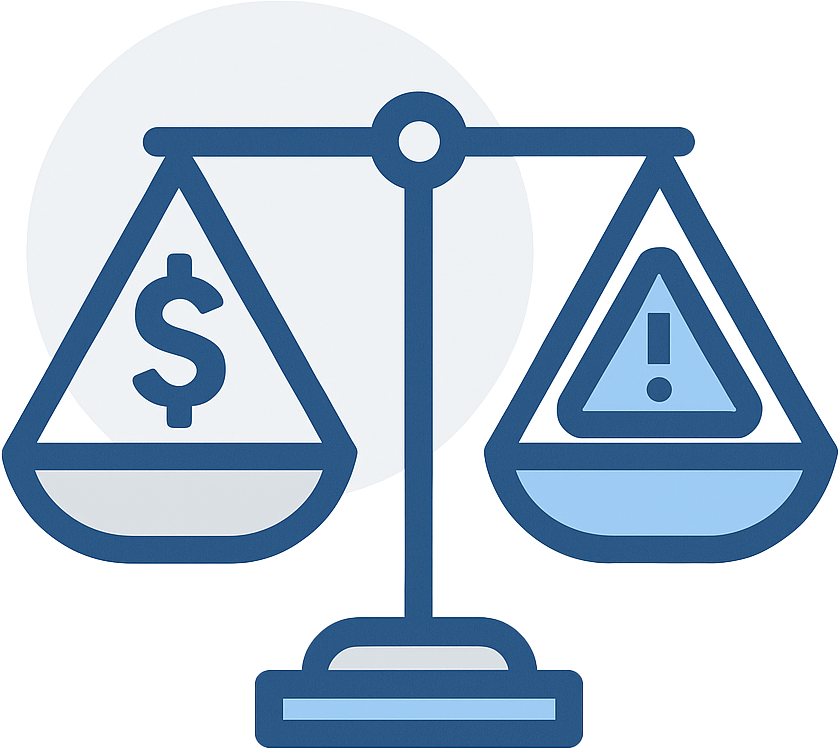NPDES Stormwater Permits 101: Your Complete Guide
What’s an NPDES Stormwater Permit? How much does it cost? Who actually needs one… and what happens if you skip it or get it wrong?
If you’re asking any of those questions, you’re not alone. These permits are one of the most common environmental requirements businesses run into, and also one of the most confusing. Between vague regulatory language, different rules by state, and unclear enforcement, it’s easy to feel stuck trying to figure out what applies to you.
That’s why we created this guide. We’re breaking down everything you need to know about NPDES Stormwater Permits in plain language, so you can stop guessing, get compliant, and get back to focusing on your actual work. Whether you're new to this or revisiting your current plan, we’ll help you understand what matters, what to look out for, and how to stay on solid ground.
Still have questions when you're done? That's exactly what we're here for - reach out to talk to an NPDES stormwater permit expert. Okay, let’s dig in.
What Is an NPDES Stormwater Permit, Really?
NPDES stormwater permits are one of the most common and most misunderstood environmental requirements businesses face. They’re part of the Clean Water Act and exist to prevent polluted runoff from contaminating rivers, lakes, and other waterways.
NPDES stands for National Pollutant Discharge Elimination System. In plain terms, it’s the program that regulates what water is allowed to leave your site. These permits set limits on pollutants and often require regular monitoring and a formal Stormwater Pollution Prevention Plan (SWPPP), among other requirements. But more on those later.
An NPDES permit defines your site’s responsibilities when it comes to water - everything from how you manage outdoor materials, to what gets documented, to how often you inspect for problems. If stormwater from your site discharges into a ditch, stream, or municipal system, you may be on the hook.

What’s the Difference Between Stormwater and Process Water?
When we talk about stormwater in the context of NPDES permits, we’re not just talking about rain. Stormwater is any precipitation that hits your site and flows off, picking up whatever it touches along the way. That includes things like snow, sleet, and hail picking up dust, dirt, oils, grease, chemicals, metals, trash, and more.
Once that runoff leaves your property and enters a ditch, storm drain, or waterway, it becomes a potential pollutant source… and that’s when it’s regulated. Even sites that look “clean” can discharge harmful levels of sediment or nutrients if controls aren’t in place.
Process water, on the other hand, is water that’s been used in your business activities, like washing equipment, cooling machinery, or part of a manufacturing process. It’s intentionally used as part of your operation.
Most of the time, when people refer to NPDES permits, they’re talking about "stormwater permits" specifically. But in some cases, your NPDES permit may also authorize discharges of process water - known as a "dual-use" discharge permit. Much of the time that's strictly forbidden though, so it’s definitely not something you can assume.
Whether process water is allowed, and under what conditions, depends entirely on the terms of your particular permit. Some facilities have separate authorizations for process water, while others are strictly limited to stormwater only. If you’re discharging anything beyond stormwater, it’s essential to double-check what your permit actually covers.
For more on this, check out:
What Is Considered a “Discharge”?
At its core, the entire purpose of NPDES permitting is to control discharges that could harm the environment. But here’s where a lot of businesses get tripped up - many assume they don’t “discharge” anything. In reality, that’s almost never true.
A discharge is any time stormwater (or process water) leaves your property. It doesn’t have to flow directly into a river or lake. If runoff from your site flows into a ditch, a pipe, a gully, etc. - that’s a discharge. So even it runs off the back of your property into a wooded area, that still counts.
And yes, drainage systems count too. If water runs into a nearby stormdrain that leads to a municipal separate storm sewer system (MS4), that’s your discharge point, even if you never see where it ends up. These systems often drain directly into local waterways without treatment, which is why they’re so closely regulated.
And to make things even more complicated, some states also regulate discharges to groundwater. That means if your site collects stormwater in a retention pond or basin, and that water seeps into the soil over time, it might still be considered a regulated discharge! This isn't common, but it does exist.
Bottom line: if water leaves your site in any form - surface runoff, pipe outfall, or even slow infiltration - it could trigger NPDES requirements. Don’t assume you're in the clear just because you don’t see a stream nearby.

Same Law, Different Rules: Who Regulates NPDES Permits?
While NPDES permits are part of a federal program, don’t expect a single set of rules nationwide. In fact, most of the details, from how you apply to how you stay compliant, depend entirely on where you’re located.
That’s because most states have what’s called “delegated authority.” In simple terms, the EPA allows states to run their own stormwater permitting programs, as long as they follow the general framework set by the Clean Water Act, at a minimum. That means each state puts its own stamp on how the rules are written, enforced, and applied - usually making things more strict than the federal standard.
Some states and territories just stick with the national NPDES program, keeping those federal rules as their own. Others have entirely different programs. In New Jersey, for example, permits are issued through the NJPDES program. Cross the river into New York, and you’re dealing with SPDES. Even the acronyms are different! And it’s not just a branding choice, the variation runs deep.
Fees, forms, deadlines, inspection requirements, and what qualifies as a discharge all change depending on the state. Something considered routine in one location might require special approval in another. That’s especially challenging for companies operating across multiple states - there’s no centralized system, no one-size-fits-all checklist, and often no clear guidance unless you know exactly where to look.
This patchwork approach makes it critical to understand your state’s specific rules, not just the federal ones.
Who Actually Needs an NPDES Stormwater Permit?
A surprising number of facilities fall under NPDES rules, and many don’t realize it. If you have outdoor operations where stormwater could pick up pollutants and flow off-site, you’re likely required to have a permit.
Common industries include:
- Manufacturing
- Metal recycling and salvage yards
- Ready-mix concrete and asphalt plants
- Waste transfer and storage sites
- Marine terminals and railyards
- Trucking and fleet maintenance facilities
But you don’t have to be a major industrial player. Even small operations can trigger permit requirements depending on what’s exposed to rain, like drums, piles, tanks, or equipment stored outside.
And here’s the catch: whether you actually need a permit depends entirely on your location. Again, even though the NPDES program is federal, the details are (most often) controlled at the state level - with different names, standards, and enforcement thresholds. The only real way to know is to dig into the regulations where you operate.
Not sure how to do that? We can help you figure out if you need a permit - no cost, no strings. Reach out! Or if you're just looking for more info, check out our article on who needs a stormwater permit here!

What’s the Difference Between General and Individual Permits?
When it comes to NPDES stormwater permitting, not all permits are created equal. There are typically two main types: general permits and individual permits. Which one you need depends entirely on your state and the specifics of your operation.
General permits are designed to cover a whole category of similar businesses, and they’re usually faster, cheaper, and more straightforward to obtain. For example, your state might have a general stormwater permit specifically for marinas, concrete plants, or certain types of manufacturers. These permits come with pre-defined conditions and requirements, so once you’re approved, the rules are already set.
But not every state offers a wide variety of general permits. Some have many. Others might only have one or two, or might not have one available for your particular type of operation. If you don’t qualify for a general permit, whether because of your site’s complexity, the nature of your discharges, or your industry - you’ll likely need to apply for an individual permit.
Individual permits are tailored to your specific site and operations. That means they take longer to develop, require more detailed documentation, often involve public notice or review periods, and usually cost significantly more to obtain. They're more flexible in theory (since they’re developed for your specific operation), but also much more complex to apply for and manage, especially if you're new to the process.
If you’re not sure which path you qualify for, your state permitting authority or an experienced consultant (like us!) can help clarify what’s available and what’s required for your site.
Can I Handle This All Myself?
It’s a fair question, and the honest answer is: sometimes, yes.
If you’ve got the time, technical knowledge, and a willingness to wade through state-specific regulations, it’s absolutely possible to manage NPDES compliance internally. Some businesses, especially smaller or lower-risk facilities needing a simple general permit, are able to handle everything from submitting the application to developing their SWPPP to submitting reports and conducting stormwater sampling on their own.
But here’s what it usually comes down to:
- How complex is your site? The more runoff pathways, materials, or regulatory exposure you have, the harder it gets.
- What type of permit do you need? If you just need a simple general permit, you might be able to tackle it alone. A complex individual permit? Maybe not.
- Do you have staff with experience in environmental compliance? If not, the learning curve can be steep.
- How confident are you in interpreting your permit requirements? These vary by state and are often more technical than they appear.
- How much time do you realistically have to stay on top of this? Compliance isn’t one-and-done. It involves ongoing monitoring, training, and documentation.
That’s why many companies choose to bring in outside help. Working with a consultant means you don’t have to worry about missing something critical, and you get peace of mind that your permit, plan, and practices are aligned. It also frees you up to focus on running your facility instead of constantly chasing compliance tasks.
Bottom line: if you’ve got the capability and interest to manage it yourself, go for it, there's no rule that says you can't. If you're thinking about going that route, read this first: Can I get a stormwater permit myself? But if you’d rather not take on the risk or workload, partnering with someone who does this every day can save you time, money, and a lot of headaches.

How Much Does NPDES Compliance Actually Cost?
Like most things in environmental compliance, the answer is: it depends. But here’s a general ballpark.
For most facilities, getting into compliance with NPDES stormwater requirements will cost somewhere between $2,500 and $15,000 in the first year with a consultant's help. That includes things like preparing and submitting your permit application, developing your Stormwater Pollution Prevention Plan (SWPPP), installing or upgrading stormwater controls, establishing BMPs, developing a sampling protocol, training staff, and setting up a recordkeeping system.
To find out your estimated NPDES compliance cost, check out the calculator below!
Where you fall in that range depends on a few key factors:
- Whether you're starting from square one or just need a hand
- The size and layout of your site
- How urgent your timeline is
- The type of materials and activities exposed to stormwater
- Your industry’s risk profile (some are more heavily regulated than others)
- If you're addressing a previous violation or enforcement action
If you’re starting from scratch, or your site has complex runoff pathways, expect to be toward the higher end. If you’ve already done some work or your facility is small and relatively clean, you might be able to keep costs lower.
After the initial setup, you’ll have ongoing costs for sampling, training, inspections, and supplies. A good rule of thumb is to budget 10% to 30% of your initial cost annually to stay in compliance. That means $500 to $4,500 a year for most facilities - enough to cover lab testing, routine updates, and keeping your team on track.
For a deeper dive, read our article on how much stormwater permits cost here!
How Long Does NPDES Compliance Take?
This question is totally natural to ask, but it's kind of missing the point. NPDES permits are a marathon, not a sprint.
Yes, there’s a timeline for getting your permit. Depending on your state, that could take anywhere from a few weeks to several years. So yeah, it's all over the place. States with streamlined general permits can move quickly, while others (looking at you, New Jersey) are known for long delays, especially if you’re applying for an individual permit or dealing with a complex site.
But here’s the bigger point: NPDES compliance isn’t a one-time task. You don’t just get your permit and move on. Staying compliant is an ongoing responsibility, not something you can “check off” once and forget about.
Once you’re permitted, there are typically recurring obligations tied to your permit that you’ll need to keep up with. If you let those slide, you can quickly fall out of compliance, even with an active permit in place.
So the better question isn’t just “how long does it take to get a permit,” but “am I set up to maintain compliance over time?” Because that’s what really matters. If you want help in the long run, we've got your back - contact us here.

What Do I Have to Do Once I Have a Permit?
The short answer? Read your permit. Seriously. Every permit spells out exactly what you’re responsible for, and the details can vary by state, permit type, and industry. But there are some common threads that show up in nearly every NPDES stormwater permit.
Here’s what most facilities should expect:
You’ll need a SWPPP.
In most cases, you’ll either need to create or update a Stormwater Pollution Prevention Plan (which may have even been created as part of your application). These plans go by different names depending on your state, but nearly every permit requires something similar. And no, this isn’t something you download from the internet. A real SWPPP is a professional, site-specific document (often a full book or binder) that outlines your stormwater controls (BMPs), discharge points, site layout, exposed materials, and procedures for staying compliant. And if anything changes at your site, your SWPPP will need to be updated to reflect it.
You’ll need to implement BMPs.
Stormwater Best Management Practices (BMPs) are the physical, procedural, and structural controls you put in place to prevent stormwater pollution. These can include things like spill prevention procedures, covered storage areas, secondary containment, stabilized entrances, or even vegetated swales and retention ponds. Your permit and your SWPPP will outline which BMPs are to be used at your site. But the key is that they must be implemented, maintained, and updated as your site or operations change.
You’ll have to track your discharges.
This usually includes routine inspections and actual stormwater sampling. In simple terms: you take a sample (literally collecting water into a bottle) on a set schedule - monthly, quarterly, or another regular interval - and send it to a lab for analysis. The results are compared to pollutant benchmarks and limits in your permit, and you’ll typically need to report those results through Discharge Monitoring Reports (DMRs) or similar forms. Forget to grab a sample, go over the limits, or miss a reporting deadline, and you could be looking at violations, even if everything else seems in order.
Your staff will need training.
Anyone who has a role in keeping stormwater clean - from equipment operators to site supervisors - needs stormwater training. That might mean field crews who handle materials or maintenance, but it can also include management, depending on your operation. Training usually isn’t optional, and it almost always has to be done annually.
You’ll need to keep good records.
Every inspection, every sample, every training session, all of it, needs to be documented and kept for a set period of time (often 3–5 years). Environmental documentation is one of the most common places we see facilities slip up. Your SWPPP typically serves as the central hub for these records, and if you can’t produce them during an inspection, it’s a problem.
You'll be inspected.
Regulators have the authority to visit your site, often unannounced, to check your stormwater controls, review your discharge points, and audit your documentation. If they find anything wrong, they can issue violations and fines - something you definitely want to avoid. Once you're on the books, you're on the government's radar. It’s not a matter of if they’ll visit; it’s a matter of when. And when they do, you’ll want to be ready.
Bottom line: holding a permit comes with real responsibilities. It’s not just a piece of paper, it’s an ongoing obligation to operate your site in a way that protects local waterways. If you fall behind on even one of these areas, you could find yourself out of compliance fast.

What Happens If I Don’t Get a Permit or I Get a Violation?
If your facility discharges stormwater and you don’t have a permit (or you have a permit but you're found to be non-compliant), you’re violating both federal and state law. And it might not just be a slap on the wrist. Environmental agencies take unauthorized discharges seriously, and the consequences can be severe.
We’ve seen facilities hit with six-figure penalties, court-ordered cleanup mandates, and lawsuits from downstream property owners or environmental groups. Once enforcement starts, you don’t get to choose whether you want to comply, you’ll be forced to, under much less favorable conditions.
And the fines, while steep (check out our violation calculator to see how quickly they rack up!) are just the starting point. Harm to your company's reputation, loss of customers, bad press, and cleanup costs are all very real possibilities if you're found to be polluting and not following the rules.
Skipping the permit process or neglecting compliance may save you time upfront, but the risks aren’t worth it. Enforcement agencies can (and do) show up unannounced, especially if they receive a tip or notice issues during site reviews. Once you’re on their radar, everything gets harder.
If there’s even a chance your operations could be subject to NPDES requirements, now’s the time to check. It’s a lot cheaper to get it right proactively than to deal with it after the fact.
How RMA Helps You Stay Compliant, Without the Guesswork
If you're facing NPDES requirements, figuring it all out on your own can feel overwhelming. For some facilities, it’s possible on your own if you have the time, training, and resources to manage it in-house. But for many businesses, bringing in a partner like RMA is the most effective way to get compliant and stay that way.
Whether you’re starting from scratch or already have a permit in place but need help staying on top of it, we can meet you where you are. We work with facilities at every stage - from first-time applicants to businesses looking to update outdated SWPPPs, improve sampling practices, or tighten up recordkeeping ahead of an inspection.
Our approach starts with a full review of your site and operations. From there, we determine whether you need coverage under a General or Individual Permit, then handle the application, develop or revise your SWPPP, and help implement the best management practices (BMPs) your site needs to meet permit conditions.
We also support your team with inspections, guidance on sampling, staff training, reporting, and ongoing compliance management. Whether you just need a one-time setup or a long-term partner, we’re here to make the process easier and more predictable.
If you’re unsure where you stand, or just want a second opinion, reach out here. We’ll help you figure out what applies to your site, what’s working, and what needs attention. No pressure, no cost. Let’s take the stress out of stormwater compliance.
















